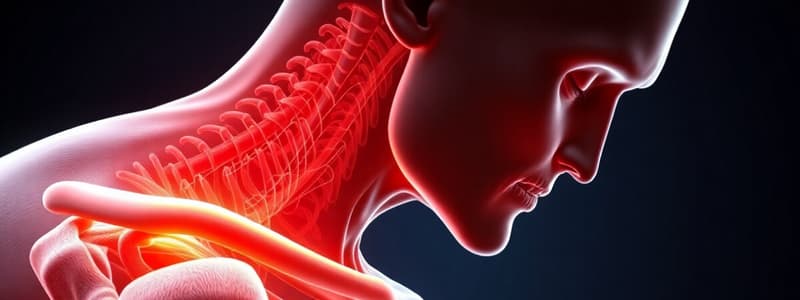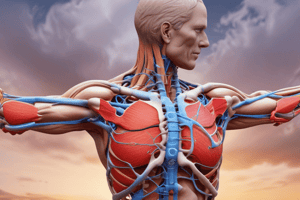Podcast
Questions and Answers
What is the primary cause of secondary impingement?
What is the primary cause of secondary impingement?
- Narrowing of the glenohumeral joint
- Excessive humeral rotation
- Inflammation of the rotator cuff
- Excessive GH joint mobility or scapular dyskinesis (correct)
Which symptom is commonly associated with secondary rotator cuff impingement?
Which symptom is commonly associated with secondary rotator cuff impingement?
- Loss of strength in the forearm
- Pain and weakness during overhead motions (correct)
- Numbness in the fingers
- Decreased range of motion in the elbow
How does muscular fatigue affect the rotator cuff during repetitive overhead movements?
How does muscular fatigue affect the rotator cuff during repetitive overhead movements?
- It prevents compression of the rotator cuff on the coracoacromial arch
- It enhances the stabilizing function of the rotator cuff
- It decreases stabilizing function, allowing superior migration of the humeral head (correct)
- It has no effect on shoulder stability
What can contribute to impingement in patients with scapular dyskinesis?
What can contribute to impingement in patients with scapular dyskinesis?
What physical examination aspect is NOT typically assessed for patients with secondary impingement?
What physical examination aspect is NOT typically assessed for patients with secondary impingement?
What is the most common cause of pain around the shoulder?
What is the most common cause of pain around the shoulder?
Which condition is NOT part of the rotator cuff syndrome?
Which condition is NOT part of the rotator cuff syndrome?
What symptom is commonly associated with shoulder impingement syndrome?
What symptom is commonly associated with shoulder impingement syndrome?
What occurs if rotator cuff impingement is not recognized and addressed early?
What occurs if rotator cuff impingement is not recognized and addressed early?
During which stage of Neer's impingement does edema and inflammation occur?
During which stage of Neer's impingement does edema and inflammation occur?
What type of shoulder movement may produce a painful arc of abduction in Stage 1 of impingement?
What type of shoulder movement may produce a painful arc of abduction in Stage 1 of impingement?
Which statement is true regarding muscular function during rotator cuff impingement?
Which statement is true regarding muscular function during rotator cuff impingement?
What is recommended during the assessment of a patient with impingement syndrome?
What is recommended during the assessment of a patient with impingement syndrome?
What is a primary cause of shoulder impingement?
What is a primary cause of shoulder impingement?
Which symptom is associated with primary shoulder impingement?
Which symptom is associated with primary shoulder impingement?
What structural factor can increase the risk of subacromial impingement?
What structural factor can increase the risk of subacromial impingement?
Which test is used for diagnosing shoulder impingement?
Which test is used for diagnosing shoulder impingement?
Which of the following describes pain experienced in primary shoulder impingement?
Which of the following describes pain experienced in primary shoulder impingement?
What is a common sign of shoulder weakness in primary impingement?
What is a common sign of shoulder weakness in primary impingement?
How is rotator cuff strength typically affected in primary impingement?
How is rotator cuff strength typically affected in primary impingement?
Which statement about primary shoulder impingement is accurate?
Which statement about primary shoulder impingement is accurate?
What is the primary focus of the late phase of rehabilitation?
What is the primary focus of the late phase of rehabilitation?
Which exercise is recommended during the intermediate phase of rehabilitation?
Which exercise is recommended during the intermediate phase of rehabilitation?
What degree range is allowed for isotonics to begin after effective cuff isometrics?
What degree range is allowed for isotonics to begin after effective cuff isometrics?
Which of the following movements should be avoided during rehabilitation?
Which of the following movements should be avoided during rehabilitation?
How often should strength training be performed during rehabilitation?
How often should strength training be performed during rehabilitation?
What type of exercises should begin at the late phase of rehabilitation?
What type of exercises should begin at the late phase of rehabilitation?
What should be the patient’s status before progressing to the late phase?
What should be the patient’s status before progressing to the late phase?
Which of the following techniques is part of the initial phase of rehabilitation?
Which of the following techniques is part of the initial phase of rehabilitation?
What condition often results from posterior capsular tightness?
What condition often results from posterior capsular tightness?
What is the primary complaint of patients under 35 experiencing internal impingement during repetitive overhead activities?
What is the primary complaint of patients under 35 experiencing internal impingement during repetitive overhead activities?
Which of the following is commonly performed to address internal shoulder impingement?
Which of the following is commonly performed to address internal shoulder impingement?
What physical examination finding is associated with internal shoulder impingement?
What physical examination finding is associated with internal shoulder impingement?
What approach is emphasized during physical therapy rehabilitation for shoulder impingement?
What approach is emphasized during physical therapy rehabilitation for shoulder impingement?
Which stretching technique is recommended once full range of motion is achieved for shoulder impingement?
Which stretching technique is recommended once full range of motion is achieved for shoulder impingement?
What is a common characteristic of the tears associated with internal impingement?
What is a common characteristic of the tears associated with internal impingement?
Which action may help facilitate gains in range of motion before exercise?
Which action may help facilitate gains in range of motion before exercise?
Flashcards are hidden until you start studying
Study Notes
Impingement Syndrome, Supraspinatus Tendinitis, and Cuff Disruption
- Pain and/or weakness during certain movements of the shoulder.
- Referred pain or paresthesias into the region of the deltoid insertion and upper lateral arm.
- A thorough examination of the upper extremity and axial spine is necessary to rule out other pathology.
- Rotator cuff impingement alters muscular function of the cuff and results in diminished dynamic control of the glenohumeral (GH) joint.
Stages of Impingement Syndrome
- Stage 1: Edema and inflammation.
- Stage 2: Fibrosis and Tendinitis.
- Stage 3: Tears and Tendon Degeneration
Primary Impingement
- Primary subacromial impingement is the result of an abnormal mechanical relationship between the rotator cuff and the coracoacromial arch (acromion, coracoacromial ligament, and/or coracoid process).
- Primary impingement can also be caused by congenital anomalies, degenerative spur formation, unfused acromion (Os acromiale), degenerative spurs on the undersurface of the acromion, malunion/nonunion of fracture, abnormal shape after surgery or trauma, thickening of tendon from calcific deposits, tendon thickening after surgery or trauma, increased prominence of the greater tuberosity from anomalies or malunions.
- Symptoms include anterolateral shoulder and upper lateral arm pain, inability to sleep on the affected side, shoulder weakness, and difficulty performing activities at or above the level of the shoulder.
Special Tests for Diagnosis
- Hawkin’s sign
- Neer impingement sign
- Empty can sign (Jobe’s test)
- Painful arc
- External and internal rotation resistance
- Strength tests
- O’Brien’s test
Secondary Impingement
- Secondary impingement is a clinical phenomenon that results from a “relative narrowing” of the subacromial space.
- Contributing factors include excessive GH joint mobility or scapular dyskinesis.
- Symptoms are caused by excessive demands placed on the rotator cuff to dynamically stabilize the shoulder.
Internal Impingement
- Posterior shoulder pain produced by contact of the greater tuberosity with the posterosuperior aspect of the glenoid when the shoulder is abducted to approximately 90 degrees and fully externally rotated, produces impingement of the posterior rotator cuff, capsule, and labrum.
- Internal impingement is often present in normal physiologic motion but can become pathologic with repetitive overhead activities.
- Pathology consists of undersurface tears of the posterior supraspinatus and/or anterior aspect of the infraspinatus tendon and often includes superior labrum anterior to posterior (SLAP) tears.
- Patients are typically under 35 years of age, involved in repetitive overhead abduction and external rotation demand activities.
Physical Therapy Rehabilitation
- A comprehensive rehabilitation program for shoulder impingement should follow a progression of phases based on functional improvement and pain reduction.
- Modalities such as heat applied before exercise may facilitate gains in ROM. Ice application following resistance exercises.
- Active and active-assisted ROM in the scapular plane, posterior capsule stretching, and manual therapy techniques should be used to address specific GH joint capsular, scapulothoracic joint, or spinal mobility limitations.
- Strength training should progress through initial, intermediate, and late phases.
- Initial phase focuses on scapular neuromuscular control, closed chain exercises, rotator cuff isometrics, and limited range isotonics.
- Intermediate phase progresses strengthening and attains full range of motion.
- Late phase focuses on restoration of shoulder girdle strength, neuromuscular control, and maintenance of normal mobility.
- Gradually return to traditional weightlifting exercises; Caution is recommended when returning to barbell pressing movements (bench, incline, and military presses) and dips because these movements can result in a return of symptoms. Behind the neck pull-downs and military press should be avoided.
Jobe’s Relocation Test
- A test that helps diagnose posterior impingement.
Studying That Suits You
Use AI to generate personalized quizzes and flashcards to suit your learning preferences.




